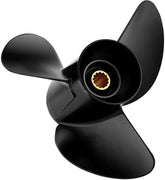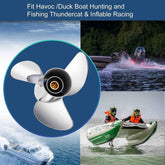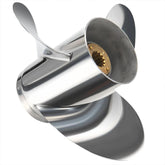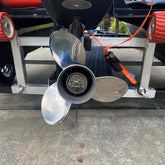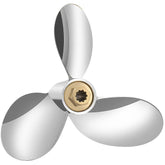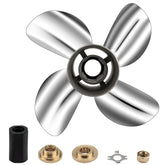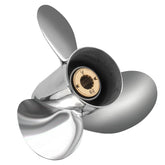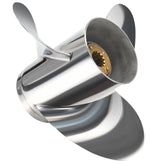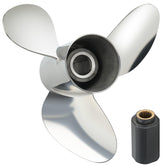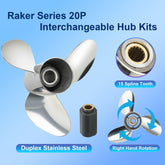The Ultimate Boat Propeller Guide: Selection & Performance Tuning
You hit the throttle. The engine roars, the bow rises, but the boat feels… sluggish. Or perhaps you are cruising, and the vibration in the steering wheel is numbing your hands. Whether you are navigating the shallow rivers of the Midwest or the open saltwaters of Florida, the connection between your engine and the water defines your entire boating experience.
As a dedicated boat propeller manufacturer, VIF Marine understands that the propeller is the gearbox of your boat. It is not just a piece of metal; it is a precision-engineered hydrofoil. Yet, most boaters are intimidated by the terminology. Pitch? Rake? Cup? Spline count?
In this comprehensive guide, we are ditching the confusion. We will walk you through everything from using a prop finder effectively to understanding complex hydrodynamics. We will explain why that mercury prop selector might be giving you generic advice and how to find the exact boat props tailored to your hull.
If you are looking to buy boat propeller replacements that outperform stock parts, or simply need to understand the difference between stainless steel props and aluminum, welcome to the only guide you will ever need.
Part 1: The Anatomy of Propulsion (Beyond the Basics)
Before you type "prop calculator" into a search engine, you need to understand the physics at play. Many users visit our Boat Propeller Online store knowing they need a replacement, but they don't know why their current one failed them.
1. Diameter and Pitch: The Golden Ratio
Every propeller has two numbers stamped on it (e.g., 14.5 x 19).
-
Diameter: The circle the blades make as they rotate. Heavy boats (pontoons, cruisers) need larger diameters to push more water.
-
Pitch: The theoretical distance the prop moves forward in one revolution. This is the most critical factor for RPM.
The Golden Rule: 1 inch of pitch change equals approximately 150-200 RPM. If your engine is over-revving (hitting the limiter), you need to increase pitch. If your engine is groaning and can't reach its Wide Open Throttle (WOT) range, you need to decrease pitch.
2. Rake and Cup: The Secret Sauce
This is where generic boat prop calculator tools fail. They calculate pitch, but they ignore geometry.
-
Rake: The angle at which the blades tilt back. High-rake propellers (like our YBS propeller or similar chopper propeller styles) create "bow lift." They physically lift the boat's nose out of the water, reducing drag and increasing speed.
-
Cup: A small lip on the trailing edge of the blade. It acts like a grip, allowing the prop to hold water better in tight turns or turbulent water.
For a deeper dive into how we engineer these geometries, check out our article on How Boat Propellers Are Manufactured.
Part 2: The "Prop Selector" Myth & Brand-Specific Guides
A common frustration we hear: "I tried the mercury outboard prop selector, but it recommended three different props. Which one do I buy?"
Automated selectors are great starting points, but they lack nuance. As a manufacturer, we categorize our outboard propellers by "Engine Groups" based on the gearcase size and spline count. Here is how to navigate the market by brand, using VIF’s precision engineering data.
1. For Mercury & Mercruiser Owners
Mercury engines are the workhorses of the marine world. Whether you have a 150HP outboard or a massive Mercruiser sterndrive, the fitment usually comes down to the spline count.
-
The 15-Spline Standard: Most Mercury outboards (40HP to 150HP+) use a 15-tooth spline shaft.
-
The Recommendation: If you are replacing a standard aluminum prop (like the Black Max), our MEGARA Series is the direct propeller for MERCURY replacement. It mirrors the blade surface area to ensure your handling remains predictable.
-
Performance Upgrade: Looking for speed? Moving from a 3-blade aluminum to a stainless steel propeller (like our Polastorm equivalent to the vengeance propeller) will reduce blade flex and improve top-end speed.
Note on Compatibility: Many boaters search for a quicksilver prop selector or mercury propeller chart. Save time by checking the hub. If it’s a Flo-Torq II style hub, our Polaflex interchangeable hub kits are 100% compatible.
2. For Yamaha Owners
Yamaha outboards are famous for their reliability, but they are sensitive to "prop chatter" (that rattling noise when shifting).
-
The "G" Series: If you see a "G" stamped on your Yamaha prop, you are running a standard 15-spline shaft for 150-300HP engines.
-
The Solution: Our YANTA Series is specifically geared towards Yamaha’s lower unit geometry. Unlike generic aftermarket props, the YANTA series accounts for Yamaha’s exhaust flow characteristics.
-
Shift Dampening: We utilize specialized rubber bushings in our hubs to absorb the "clunk" of shifting gears, similar to Yamaha's SDS system. You can browse our specific propeller for yamaha collection to find your exact match.
3. Suzuki and Honda: The High-Thrust Challenge
Suzuki 4-strokes and Honda outboards often use different gear ratios than Mercury or Yamaha.
-
Suzuki: Known for large gear ratios, they can swing a larger diameter prop. If you use a standard diameter prop on a Suzuki, you might experience high slip. Our SEMA Series is designed with the larger blade surface area that Suzuki engines crave. (See: propeller for Suzuki).
-
Honda: From the BF series to the larger V6s, Honda engines require smooth power delivery. Our propeller for Honda lineups optimize midrange fuel efficiency, which is usually the priority for Honda owners.
4. Volvo Penta & Tohatsu
Finding parts for these can be tricky.
-
Volvo: If you are running an SX drive, you need a 19-spline prop. We stock specific propeller for Volvo aluminum and stainless options that replace the standard OEM specs.
-
Tohatsu: Often shared platforms with Mercury or Honda depending on the year. Always count your splines! A propeller for tohatsu might be interchangeable with Nissan Marine parts.
Part 3: Solving the Altitude Equation
This is a specific technical question that stumps even experienced captains: "Do I need higher or lower pitch propellers for altitude on a boat?"
The Answer: LOWER.
Here is the science: Engines breathe air. As you go up in elevation (like boating in Lake Tahoe or the mountain lakes of Arkansas), the air density decreases.
-
The Power Loss: Your engine loses approximately 3% of its horsepower for every 1,000 feet of elevation. At 5,000 feet, you are missing 15% of your power.
-
The Symptom: If you use your sea-level prop, the engine doesn't have the power to spin it to the redline. It "bogs down," causing strain and overheating.
-
The Fix: You must "gear down." For every 3,000 feet of elevation, drop your propeller pitch by 2 inches.
-
Sea Level: 19" Pitch
-
High Altitude: 17" Pitch
-
If you are planning a trip to high-altitude lakes, do not rely on a standard quicksilver propeller calculator designed for sea level. Manually adjust down.
Part 4: Stainless Steel vs. Aluminum – The Eternal Debate
When you browse boat props for sale, the price difference is obvious. But is stainless steel worth the extra cost?
Aluminum Props (The Budget-Friendly Savior)
-
Pros: Inexpensive, lightweight. If you hit a rock, the aluminum blades will shear off or bend, sacrificing themselves to save your expensive lower unit gears.
-
Cons: They flex under load. As you push hard, the blades bend slightly, changing the pitch and losing efficiency.
-
Best For: Fishing boats, pontoons, and waters with hidden hazards (stumps, rocks).
Stainless Steel Props (The Performance King)
-
Pros: Rigid. Stainless steel props are thinner (less drag) and do not flex. They hold their shape at 60 MPH+, giving you better top speed and acceleration.
-
Cons: Expensive. If you hit a rock, the steel is stronger than the gears inside your engine. The shock is transferred to the drivetrain.
-
Best For: Bass boats, offshore cruisers, and anyone looking for maximum performance propeller stats.
Check out our Hot Selling collection to see high-performance steel designs.
Part 5: Hardware, Hubs, and Installation
A propeller is only as good as how it is attached. You might find a ship prop or a boat motor prop that looks right, but if the hardware is wrong, you are staying at the dock.
The Hub Revolution
Gone are the days of pressed-in rubber hubs that required a machine shop to replace. Modern systems use interchangeable hubs.
-
VIF Polaflex System: This is our answer to the industry standard. It consists of a polymer bushing that absorbs shock.
-
Installation: You don't need complex brp installation instructions. It’s a drop-in system: Thrust Washer -> Hub -> Prop -> Locking Washer -> Nut.
Specialized Hardware
Sometimes you need more than just the prop.
-
TBX Hubs: Owners of Evinrude G2s often look for a tbx bushing kit for raker propeller. We supply compatible hardware kits that handle the high torque of these modern 2-strokes.
-
Jet Drives: For PWC owners or shallow water runners, we also support jet tw components and 2 in jet impeller replacements. (Always verify the impeller diameter, as pwc parts have tighter tolerances than outboards).
-
BRP/Johnson: Older OMC engines can be tricky. If you are looking for instruction brp or brp instruction manuals for older drives, contact our support. We have legacy knowledge on 13-spline and 14-spline OMC shafts.
Part 6: Local vs. Online – Where should you buy?
This is the dilemma. You could drive to 824 cedar lane to 126 church st lodi (a popular route for local marine shops in that area) or visit a massive boat motor superstore palm harbor florida. You might even have a trusted local mechanic like the famous trader bill hot springs arkansas.
We love local dealers. They are the backbone of the boating community. However, local inventory is limited by shelf space.
Why Buy from a Manufacturer Online?
-
Selection: A local shop might have one 19" prop. We have the 19" in three different blade geometries (MEGARA, SEMA, YANTA).
-
Price: By cutting out the middleman, VIF Marine offers boat propellor pricing that often beats used parts on eBay.
-
Accuracy: When you use our site, you aren't guessing. You are matching specs directly from our factory engineering sheets.
-
Availability: Obscure parts? Need a prop pitch calculator verification for a 1985 Tohatsu? We have the data.
Whether you are shopping at donsmarine.com or browsing our catalog, ensure you are getting a brand-new, balanced product, not a "reconditioned" prop that might be out of true.
Part 7: Troubleshooting Your Ride (The "Prop Finder" Checklist)
Before you click "Add to Cart," run through this checklist. This is the manual prop selector process used by pros.
1. Check Your RPM Run your boat at Wide Open Throttle (WOT) with a normal load.
-
Is it too low? You are "over-propped." Reduce Pitch.
-
Is it too high? You are "under-propped." Increase Pitch.
2. Ventilation vs. Cavitation
-
Ventilation: Air getting sucked into the blades (engine revs up wildy). Usually caused by mounting the engine too high or tight turns.
-
Cavitation: Water boiling off the blades due to low pressure (burn marks on the metal). Caused by damaged blades or poor cup design.
-
The Fix: If you experience this, switching to a 4-blade prop (available in our outboard props section) often cures ventilation by gripping the water better.
3. The "Hole Shot" If your boat takes forever to get on plane, you have poor hole shot.
-
The Fix: Drop 1-2 inches of pitch or switch to a vented prop (like the mercury outboard prop selector often suggests for bass boats). Vents allow exhaust to aerate the blades, spinning them up faster for a quick launch.
Conclusion: Stop Guessing, Start Boating
Boating is supposed to be fun, not a math homework assignment involving a quicksilver prop selector and confusing charts.
At VIF Marine, we have integrated decades of boat propeller manufacturer expertise into our product lines. Whether you need a rugged aluminum workhorse for your pontoon or a screaming stainless steel blade for your center console, we have the fit.
Don't settle for "good enough." Don't drive all over town looking for boat props for sale in dusty boxes. Visit our Boat Propeller Online store, select your engine, and feel the difference a precision-engineered propeller makes.
Ready to find your match?


